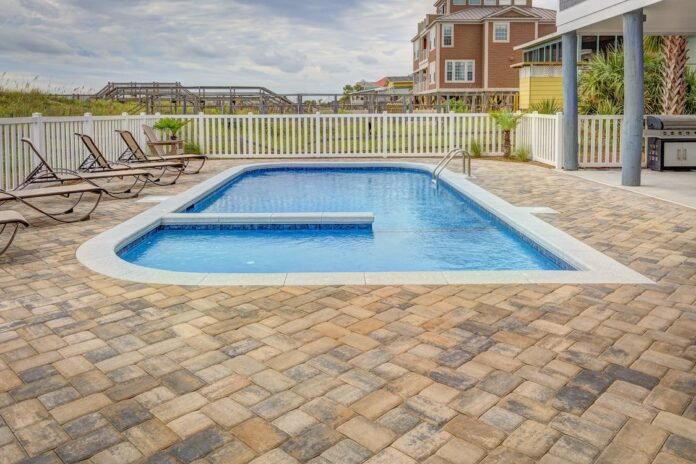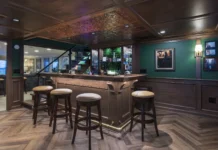Last Updated on January 24, 2024 by Asfa Rasheed
Swimming pool design unveils a dynamic process that extends far beyond the surface. Beyond the refreshing waters lies a meticulous orchestration of vision, functionality, and craftsmanship. A deep dive into the swimming pool design process reveals the intricacies involved in transforming an idea into a tangible, well-crafted aquatic space. Join and explore the depths of this process, delving into the art and science behind crafting more than just pools—creating immersive, harmonious aquatic environments.
Table of Contents
Site Analysis and Assessment
The topography of the designated area is thoroughly scrutinized to identify any potential challenges or opportunities for creative design solutions. The foundation and construction requirements for the pool are mostly determined by the state of the soil, which guarantees structural integrity. Climate considerations are factored in to optimize pool placement and orientation, maximizing sunlight exposure and minimizing environmental impact. By delving into these crucial aspects, designers can seamlessly integrate the pool into its surroundings, achieving a harmonious balance between the natural landscape and the designed aquatic space. This comprehensive site analysis sets the foundation for a well-informed and tailored approach to the subsequent stages of the pool design process.
Functional Design Considerations
Determining the appropriate pool size involves a thoughtful examination of the client’s needs and available space, ensuring a proportional and functional outcome. Variations in pool depth are strategically planned to accommodate diverse activities, from lounging to swimming and diving. The circulation system, a critical element in pool functionality, is meticulously designed to guarantee optimal water quality and efficient water flow. By addressing these functional aspects early in the design process, designers can create a pool that not only aligns with the client’s desires but also serves as a practical and enjoyable aquatic environment. This careful consideration of functionality sets the stage for a well-executed and purposeful pool design.
Aesthetic Elements and Style Integration
The design process places meticulous attention on shaping the pool, selecting materials, and incorporating landscaping to create a harmonious visual appeal. The pool’s shape is carefully chosen to align with the overall design vision, seamlessly integrating with its surroundings. Material selection, including finishes and coping materials, contributes significantly to the pool’s aesthetic impact while ensuring durability and longevity. Landscaping elements, such as plants and lighting, are strategically integrated to enhance the pool area’s ambiance and create a cohesive outdoor space. By addressing these aesthetic elements, the pool becomes more than a functional space; it transforms into a visually stunning focal point within the broader landscape.
Construction Planning and Coordination
Efficient construction planning and coordination are pivotal components of the swimming pool design process. This phase involves precise collaboration between designers, contractors, and suppliers to ensure the seamless realization of the envisioned pool. Detailed plans, encompassing every aspect from layout to materials, are crucial for accurate execution. Most pool remodels require intricacy as existing structures and features need careful consideration and handling. To handle any issues that may come up during the building process, timelines are set and continuous contact is maintained. This meticulous planning and coordination lay the foundation for a successful transformation, ensuring that remodels are executed with precision and efficiency.
Quality Materials Selection
Pool finishes, coping materials, and decking options are chosen with careful consideration of their aesthetic appeal and resilience over time. Opting for high-quality materials not only enhances the pool’s visual aesthetics but also contributes significantly to its structural integrity. Attention is given to factors such as resistance to wear and tear, weather elements, and chemical exposure. This meticulous selection process ensures that the materials used in the pool construction not only meet aesthetic expectations but also stand the test of time, providing a durable and aesthetically pleasing aquatic space.
Landscaping and Surrounding Elements
Landscaping elements, such as carefully selected plants and hardscaping features, are strategically incorporated to enhance the overall ambiance. Lighting plays a pivotal role not only in aesthetics but also in creating a safe and inviting environment during the evening. Thoughtful placement of these elements ensures a seamless integration with the pool, creating a cohesive outdoor living space. By considering the broader surroundings, including natural features and architectural elements, the pool area becomes a harmonious extension of the overall landscape, inviting users to immerse themselves in a well-designed and visually pleasing environment.
Conclusion
The functionality and aesthetics have emerged as a key theme, ensuring your pool not only meets your practical needs but also captivates with visual allure. The careful selection of materials stands as a testament to the commitment to durability and longevity. As you navigate through the orchestration of landscaping and surrounding elements, the outdoor space transforms into a harmonious retreat.



























